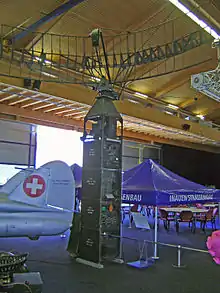LGR-1 Radar
The LGR-1 (Lightweight Ground Radar 1 ) was used by Swiss Air Force from 1948 until 1955 for positioning the planned radar air surveillance system. It is now in the Flieger-Flab-Museum at Dübendorf.

History
This radar of the first generation of mobile radar systems in World War II was in the Allied invasion of Normandy in use. In Switzerland, the system was never used in the tactical way. It was used for determining the locations of the first Swiss airspace control system the SRF Airspace monitoring and management system. The LGR-1 radar was tested at various locations, including at the military airfield Dübendorf, the Bütschelegg above Bern-Belp and in the Weisfluhgipfel the Weissfluhjoch and the Creux du Van. As weatherprotection a wooden hut was built around the LGR-1. The transportable in 10 loads lightweight radar LGR-1 was developed during the Second World War by the Bell Telephone Laboratories and Western Electric and built by Bendix in large numbers.
Specifications
- Transmitter: L-band in the frequency range 1220 - 1350 MHz
- Peak power: 400 kW
- Pulse duration: 0.2 microsecond
- Target detection range: 100 km
- Power supply: 120 Volt 400 Hz from a gasoline engine.
References
- Alber Wüst: Die Schweizerische Fliegerabwehr. 2011, ISBN 978-3-905616-20-0
- Militärische Denkmäler im Bereich der Luftwaffe (PDF)(German only)